Guide to Production Scheduling for Manufacturing
Navigate to section
- What is Production Scheduling In Manufacturing?
- Why is the Production Schedule Important in Manufacturing?
- What Are the Stages of Production Planning and Scheduling in Manufacturing Process?
- Types of Production Scheduling Manufacturing
- Examples of Production Scheduling in Real-Time Manufacturing Scenarios
- Benefits of Effective Production Schedule
- What are the Effective Methods and Techniques of Production Scheduling?
- What are the Challenges in Manufacturing Production Scheduling?
- How to Optimize Manufacturing Production Scheduling Through Software?
- How Smart Factory MOM Software Enhancing Production Scheduling?
Introduction
When you think of production scheduling, you imagine a complex process, right? If so, don’t worry. Although there’s some truth to it, the truth is that regardless of the solution you use, the essence of this process is much more practical and everyday than it seems.
Production scheduling isn’t just a matter of wishing or wanting something to happen; it’s a task that must involve anticipating what’s needed (materials, machinery, personnel, and time) so that each product can be produced on time or in the best possible way and reaches the customer at the promised time. When this forecast is inefficient, precarious, or has failed, it can impact schedule compliance and can be clearly reflected in diminished or empty shelves, delayed orders, cost overruns, losses, or complaints.
In this guide, we’ll provide you with comprehensive information about production scheduling, and how, through proper management and operation, you can leverage it to operate efficiently and profitably, satisfying your customers’ orders and increasing your efficiency.
What is Production Scheduling In Manufacturing ?
Manufacturing Production scheduling is the set of steps taken to plan, organize, and optimize the sequence of operations in a manufacturing process or the production of a product. It is commonly performed to ensure an estimate or definition of delivery dates (always seeking timely compliance), seeking to achieve efficient use of resources and maximum alignment with business objectives.
Key Factors to Be Included in Your Production Schedule

Material Availability and Lead Times
Whether in a simple manufacturing scheduling system, material availability must be considered. It is understood that the plan can fail before it even begins when lead times or inventory levels are not considered. Generating realistic schedules and avoiding downtimes due to shortages will only be possible when this information is integrated into your scheduling method, regardless of the system in use.

Machinery and Labor Capacity
Knowing, managing, and using the actual capacity of machinery and personnel is essential when creating a schedule, as the feasibility of your plan will depend on these limitations and how it can avoid overloads, bottlenecks, or downtime, and ensure that each resource operates within its actual capabilities and to the best of its ability.

Setup and Changeover Times
To optimize the production sequence, the first idea is to minimize lead times. A time consumed and typically non-negotiable is that related to adjustments or changes to the product or process. Therefore, these changes must be controlled to reduce efficiency losses and minimize downtime between tasks.

Order Priorities and Due Dates
Not all customers are equally important, nor do all products generate the same profit. Therefore, it's easy to understand that orders can have different levels of urgency.

Calendar Events and Exceptions (e.g., Maintenance)
Knowing the capacity of equipment and whether it is available for use is crucial. For example, planned events that affect resources, such as holidays, planned maintenance, or special shifts, affect resource availability (either increasing or decreasing).
Minimize production costs and delays
Within the lean methodology, reducing costs and minimizing delays are very important strategies for a company’s finances. Having a consistent schedule can help avoid waste, wait times, and last-minute emergencies, making it easy to find ways to reduce operating costs and avoid delays, directly improving your profitability without affecting quality or disrupting processes.


Ensure On-Time Delivery
Today, under the global competitiveness framework, a missed deadline is not an option: a company’s compliance rate is its reputation in numbers. To increase or maintain this reputation, accurate scheduling is the key that opens the door to just-in-time delivery control, even in changing environments. It not only streamlines delivery dates but also provides feasible, realistic dates and provides faster identification of schedule changes and system needs
Improve Operational Efficiency
When you’re looking for smoother operations, the last thing you might think is that scheduling could be a way to achieve it. Proper scheduling connects all points in the production process, eliminating friction and downtime, and even improving workflow, resulting in fewer errors and rework, and greater speed, effectiveness and efficiency.

Why is the Production Schedule Important in Manufacturing?
In the Manufacturing business world, you can’t deny that every poorly scheduled minute costs money. And every well-scheduled decision generates value. We will use a technical modification of the 5 Whys of Lean Manufacturing (commonly used in root cause analysis) to find the value of production scheduling in day-to-day operations and understand the real impact it has on profitability and competitiveness.
1. Why Is It Important to Have a Production Schedule for Short Periods (Days to Weeks)?
Because by having it, we can clearly know what needs to be produced, when, and with what available resources in short time periods, avoiding improvisation when last minute changes comes up, which allows for an operation, ensuring continuous operation in the present or immediate future at the time that we can maintain operational flow and meets delivery commitments.
2. Why Do You Need to Know This Precise Schedule in Your Process (Be It Weekly or Daily)?
Because if you don’t have a clear timeline, you may be working on unrealistic ideals, which lead to delays, bottlenecks, and inefficient use of resources. This leads to reactive decisions that affect productivity, increase costs, and reduce efficiency. If a company has reliable and real data, it can generate realistic schedules, which allow it to make decisions more accurately and to project effective income.
3. Why Does the Lack of Effective Scheduling and Problems in Its Development Affect Operations So Much?
4. Why Can the Effects of Poor Scheduling Directly Impact Business?
Because the result of poor scheduling is always reflected in inefficient operations, which on the one hand limits growth and on the other puts profitability at risk. Production normally follows the schedule defined by the schedule, but when the schedule is inaccurate, inconsistent, or unrealistic, it can lead to high costs and reduced operating margins, which affect the ability to meet demand.
5. Why Should This Matter to You as a Manufacturing Leader?
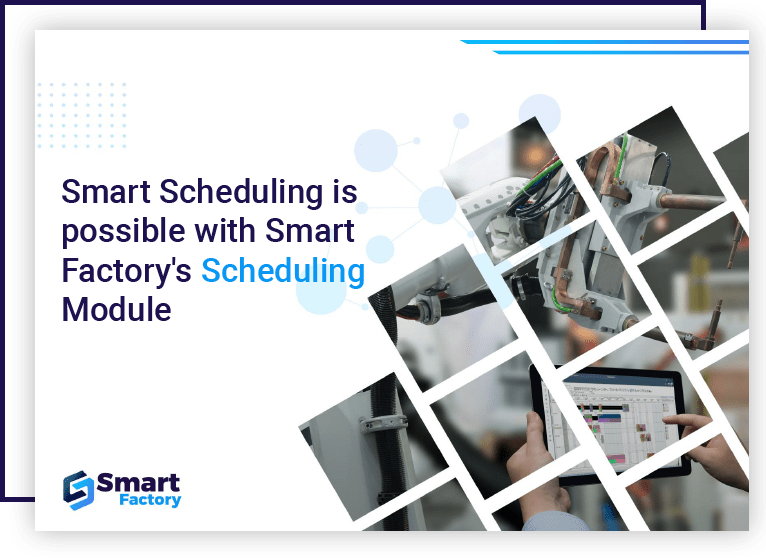
Ready to optimize your production scheduling? Download our Scheduling module brochure now and discover how its advanced tools can streamline your production operations, increase productivity, and boost efficiency.
What Are the Stages of Production Planning and Scheduling in Manufacturing Process?
Stages of Production Planning and Scheduling in Manufacturing
In order to cover and analyze these steps, let’s see it as a cycle of two integral phases that join at a conversion point and take a specific direction, which we can see in the following way:

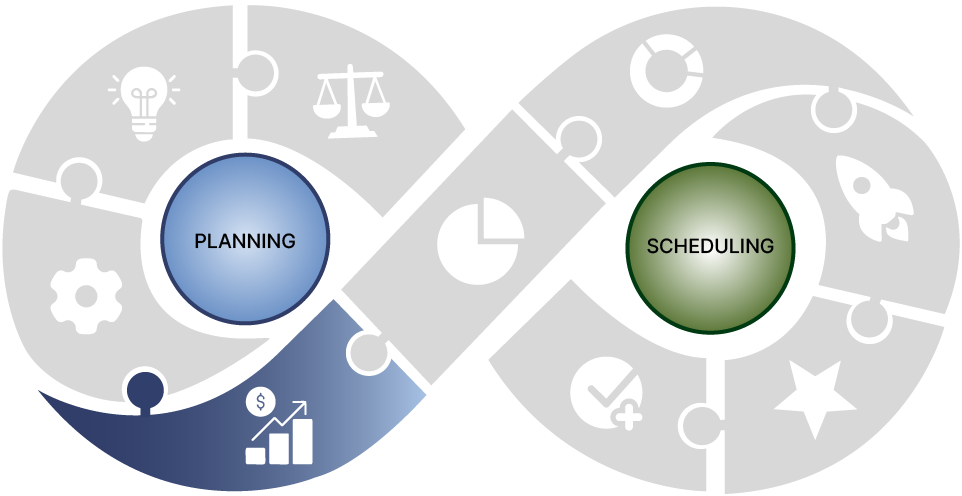
1. Demand Forecasting & Capacity Planning
- Estimate future demand based on historical data and trends.
- Evaluate planned capacity vs. expected demand.
Goal: Align capacity with demand to avoid overload or under utilization.
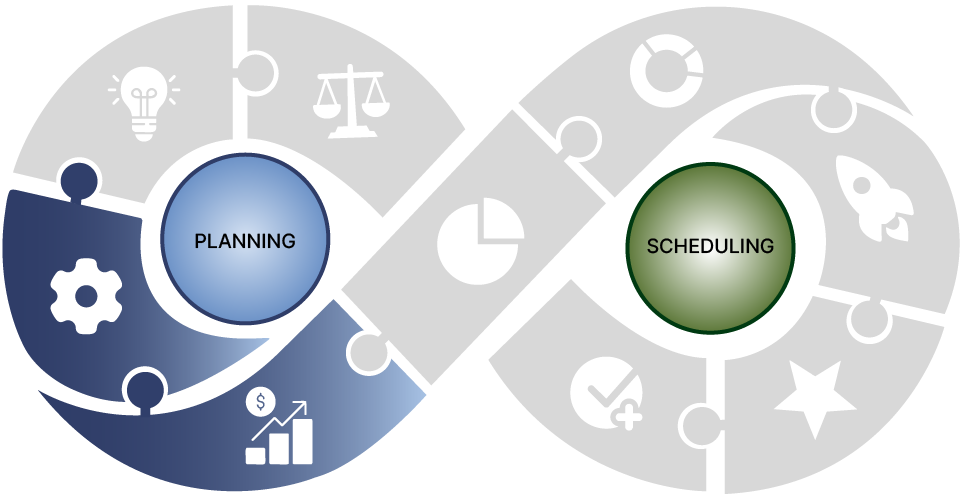
2. Materials Planning and Procurement
- Determining the materials and components needed for production.
- Coordinating with suppliers to ensure on-time deliveries (supply chain).
Goal: Project and ensure availability of material resources without excess inventory.

3. Master Production Schedule (MPS)
- Consolidation of demand vs. what will be produced, in what quantity, and over what period.
- Large-scale basis for detailed scheduling.
Goal: Overview of the long-term production plan.

4. Schedule Scenario Creation & Validation
- Simulation of multiple scheduling scenarios with evaluation of routes, times, resources, and constraints in order to identify and select the best option.
Goal: Ensure the schedule is as viable and optimal as possible.

5. Scheduling Selection
- Select the most efficient schedule aligned with the priorities and capabilities of the production system.
- This schedule is validated against real-world constraints (materials, machines, shifts).
Goal: Define the plan to be executed at the plant based on general and specific constraints.

6. Schedule Release (Schedule dispaching)
- Release of the selected schedule to the MES system or the operational/production team.
- Communication of work orders and queues, with assigned tasks, times, and resources.
Goal: Begin execution with clarity and coordination of the defined plan.
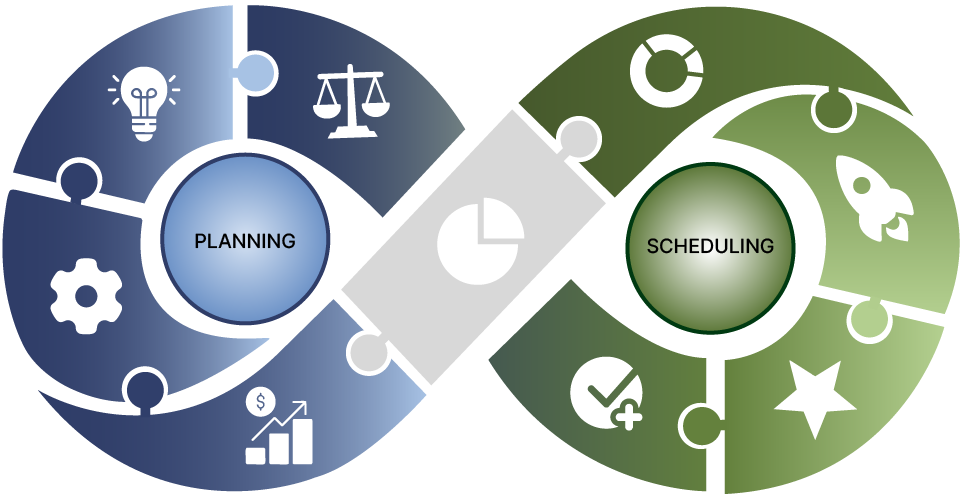
7. Production Execution
- Execution of tasks according to the released schedule.
- Record progress, actual times, and operational events.
Goal: Maintain real-time traceability of production execution, monitoring and following the expected plan.
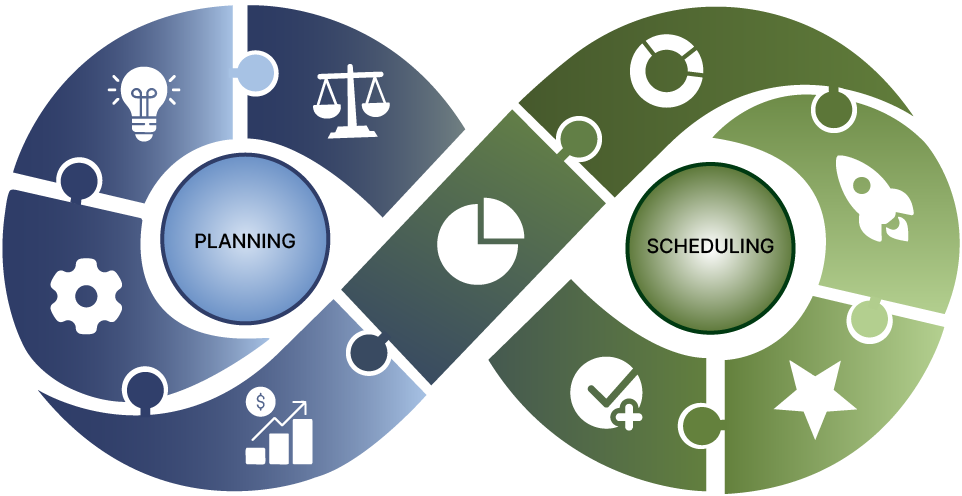
8. Production Control & Monitoring
- Supervision and monitoring of real-time progress against the defined plan.
- Detection of deviations and application of corrections. Estimation of progress and pending tasks as a basis for future planning.
Goal: Full control to reference for restarting the production assignment cycle.
Types of Production Scheduling in Manufacturing
1. Forward vs Backward Scheduling
| Aspect | Forward Scheduling | Backward Scheduling |
|---|---|---|
| Start Point | Begins from the current date or earliest possible start date | Begins from the due date or required completion date |
| Focus | Determines the earliest possible completion date | Determines the latest possible start date |
| Use Case | Useful when resources are available and you want to start ASAP | Useful when delivery deadlines are fixed |
| Flexibility | More flexible with resource allocation | More rigid, focused on meeting deadlines |

Forward Scheduling is a winner when
- Resource availability is not an issue.
- The goal is to start as soon as possible.
- Flexibility is needed to accommodate changes.

Backward Scheduling wins when
- There are strict delivery dates (unchangeable or with no option to negotiate).
- Optimizing time is a requirement (current time constraints).
- Meeting deadlines is more important than starting early.
Recommended selection strategy: Use Forward to maximize the use of priority resources and Backward when you need to meet fixed commitments to customers.
2. Finite vs Infinite Scheduling
| Aspect | Finite Scheduling | Infinite Scheduling |
|---|---|---|
| Resource Constraints | Considers actual resource availability (e.g., machines, labor) | Assumes unlimited resources |
| Realism | More realistic and practical | More theoretical and idealistic |
| Use Case | Used in detailed planning and execution | Used in high-level planning or forecasting |
| Complexity | More complex, requires accurate data | Simpler, but may lead to infeasible plans |

Finite Scheduling triumphs when
- It seeks a precise and realistic answer.
- Its resources have obvious current limitations and are expensive to use.
- It requires a timeline for the execution phase (for the near or immediate future).

Infinite Programming succeeds when
- You work on a strategic planning phase.
- You want to visualize happy path scenarios (without constraints).
- You seek ideal simulations with the speed to obtain them.
Recommended selection strategy: Only use infinite programming to plan and understand what would be the ideal (happy path) for your production, but apply finite programming to execute without surprises with real data and feet on the ground.
3. Make-to-Order vs Make-to-Stock Scheduling
| Aspect | Make-to-Order (MTO) | Make-to-Stock (MTS) |
|---|---|---|
| Production Trigger | Starts after receiving a customer order | Starts based on forecasted demand |
| Inventory | Minimal inventory; customized products | Higher inventory; standardized products |
| Lead Time | Longer, but tailored to customer | Shorter, products are ready to ship |
| Use Case | Custom manufacturing, low volume | Mass production, high volume |

Make-to-Order wins the challenge when
- A high number of customized products are manufactured.
- Excess inventory is unacceptable or must be controlled.
- Demand is medium-highly variable or specialized.

Make-to-Stock will win when
- When there is a standardized and high-volume production.
- Meeting commitments and speed of delivery are sought.
- Demand is stable and predictable at a certain level.
Recommended selection strategy: If serving niche markets is your priority, use MTO, but if you serve mass markets, use MTS. And if you work with both, don’t limit yourself; you can even combine both in hybrid models! In advanced APS systems (like Smart Factory APS) it’s possible.
4. Master Production Schedule (MPS) vs Detailed Scheduling
| Aspect | Master Production Schedule (MPS) | Detailed Scheduling |
|---|---|---|
| Level | High-level planning | Operational-level planning |
| Scope | Focuses on what to produce and when | Focuses on how and with what resources |
| Time Horizon | Medium to long-term | Short-term, day-to-day |
| Use Case | Strategic planning | Execution and control of production |

MPS wins when
- A broad, medium- to long-term vision is needed.
- When the desire is to plan what and when to produce as a future project, rather than an immediate one.
- If the goal is to keep strategic objectives under control and aligned.

Detailed Scheduling is a winner when
- The work is done on or the need is focused on day-to-day production.
- If, rather than imagining, you want to operate by assigning specific tasks to resources.
- Operational precision is required for short or immediate periods.
Recommended Selection Strategy: Before making a decision, think carefully: Is the schedule you’re looking for in the near future (i.e., today, tomorrow, or in a few weeks) or is it projected into the medium-distant future (in a few weeks or even months)? Based on this, understand that MPS is like a general long-term map, while Detailed Scheduling is like a GPS with real-time location that will guide you through every turn you need to take to keep moving forward.
Examples of Production Scheduling in Real-Time Manufacturing Scenarios
| # | Production Model | Industry/Example | Key Challenges | APS Solution Components | Key Results |
|---|---|---|---|---|---|
| 1 | Make to Stock (MTS) | Automotive Manufacturing | High-volume production, overproduction risks, stock-outs, bottlenecks, balancing assembly lines, market fluctuation. | Demand forecasting, real-time assembly line balancing, predictive analytics, automated bottleneck detection, dynamic adjustments based on historical sales data, market trends, seasonality, scenario simulation for material and delivery forecasts. | Increased throughput, reduced stock-outs and inventory costs, optimized inventory levels, improved delivery. |
| 2 | Make to Order (MTO) | Custom Furniture | High variety, order-driven production, unique customer specifications, raw material variability, meeting tight delivery deadlines, minimizing downtime. | Dynamic material planning, custom BOMs, flexible routing, resource prioritization based on delivery dates, real-time capacity planning, sequencing and resource allocation to orders, prioritization logic based on delivery requirements, constraint-based planning considering production limitations (primary and secondary), dynamic adjustments to handle delays. | Agile order response, reduced production costs, improved delivery reliability, better customer satisfaction. |
| 3 | Engineer to Order (ETO) | Custom Machinery, Complex Designs | Unique customer designs, design-to-production workflows, high customization, complex operations with unique routing, component availability synchronization, tight deadlines. | Integration of design and engineering workflows with production scheduling, dynamic resource allocation, customized BOMs, real-time capacity planning, sequencing with constraints, scenario simulation to evaluate variations in material and delivery forecasts, flexible material planning, synchronization of design approvals with material availability, critical path management. | Reduced engineering delays, optimized production starts, timely deliveries, enhanced flexibility. |
| 4 | Assembly to Order (ATO) | Industrial Equipment | Complex assemblies, component and subassembly shortages, bottlenecks in assembly lines, balancing workload across multiple assembly stations, real-time disruptions. | Load balancing for assembly lines, real-time monitoring, dynamic rescheduling based on shop floor conditions, bottleneck detection, configuration management for custom orders with multiple variants, workload balancing for different assembly stations, real-time alerts for shortages. | Shortened lead times, increased efficiency, reduced downtime, enhanced responsiveness. |
| 5 | Hybrid (Mixed MTS/MTO/ETO/ATO) | Modular Product Manufacturing | Complex hybrid workflows with mixed standard/custom components, synchronizing multiple production strategies, balancing shared resources, managing changing demand. | Flexible planning combining elements from MTS, MTO, ETO, and ATO, dynamic prioritization of orders based on customer requirements, shared resource synchronization, scenario simulation, constraint-based planning to balance production methods, integration of BOMs and routings across models, rescheduling in real time. | Efficient hybrid production, reduced delays, optimized resource utilization, adaptability to market changes. |
Benefits of Effective Production Schedule

Scheduling Constraints: Realistic Efficiency
APS enhances operational efficiency by factoring in real-world limitations such as machine capacity, tool availability, and workforce readiness. It prevents overloads and resource conflicts, ensuring smooth execution across all production stages.
- Minimizes idle time
- Manages primary and secondary resources
- Prevents delays and bottlenecks

Time Management: Dynamic Precision
APS uses advanced logic to dynamically adjust schedules in response to planned or unexpected events. Integrated with ERP and MES systems, it enables real-time monitoring and responsiveness.
- Automatic rescheduling during delays
- Seamless synchronization between planning and execution
- Smart grouping to reduce changeover times

Intelligent Material Allocation
APS ensures continuous production by intelligently managing materials, minimizing disruptions. It supports FIFO/FEFO rules and allows for customized allocation strategies.
- Waste reduction
- Flexibility during shortages
- Clear visualization of material flow

Calendars and Order Execution
APS evaluates actual resource capacity and enables simulations of both ideal and realistic scenarios. This supports strategic and operational decision-making with high accuracy.
- Multi-scenario scheduling simulations
- Calendar-based availability control
- Operational and financial advantage

Scheduling Rules: Flexible Strategies
APS adapts to market fluctuations by supporting both manual and automated scheduling rules, tailored to any production need.
- Full versatility
- Manual or automatic control
- Advanced logic for strategic decisions

Reporting and Customization: Real-Time Intelligence
APS delivers customized reports and logical recommendations based on multiple criteria, empowering informed decision-making and continuous optimization.
- Route and priority configuration
- Optimized, coherent recommendations
- Full process visibility
What are the Effective Methods and Techniques of Production Scheduling?
Every activity should have a process for how to do it, and scheduling is no exception. On a day-to-day basis, effective scheduling must be supported by proven techniques and methods backed by best practices, using tools that allow you to move from a to-do list with dates to an intelligent action plan. To better understand the methods and functions used for production scheduling, we will focus on the most important ones:
1. Gantt Charts functions
From Data to Visualization for Production Management Like You Never Thought You Would.
Production management is data-driven, but information management can be a major challenge. Gantt charts are the best way to transform hard data into clear, chronological visualizations of tasks, their duration, sequence, and relationship to other activities, all in a single view, making it easier to detect overlaps, delays, or bottlenecks before they occur.
What parts do they consist of?
- Calendar visual board: A work panel that reflects the timeframe (available, constrained, and established) where everything happens.
- Tasks/Operations: Each activity that could be added (scheduled).
- Duration: A size that represents the duration of each task.
- Dependencies/Relationships: The thread that projects which tasks have a dependency and a path.
2. Heuristic Methods: For complex problems, quick solutions!
Production scheduling always involves constantly changing variables, which often lead to complex problems that require solving in periods where time is of the essence.. For these reasons, it’s no surprise that in today’s manufacturing, being able to solve a complex production scheduling case in a short time becomes so important that, regardless of the magnitude of the reduction (be it an hour or even a minute less), it can mean the difference between losing thousands of dollars or keeping them in your pocket. Would you rather achieve; mathematical perfection or obtain viable and functional results in real time, allowing you to make agile decisions without losing effectiveness? If your answer is the latter, continue reading and learn more about heuristic methods.
What is the origin of their importance?
- Solve complex problems without the need for exhaustive or unnecessary calculations.
- Are ideal for when you need to act quickly on scenarios with dynamic data.
- They are agile solution models (flexible, fast, and effective) that can adapt to different scenarios and variations.
3. Priority Rules (SPT, LPT, EDD, CSR)
No matter how simple a process is, no process can be considered to have completely equal orders. Which leads to the million-dollar question: If I have so much to do, what do I do first and why? To answer this, we have the priority rules, which help us decide what to produce first:
Shortest Processing Time (SPT)
Generally speaking, “Whatever is quickest, let’s do it first.” This rule prioritizes tasks that are completed in the shortest amount of time.
Ideal for schedules seeking to quickly free up resource capacity to increase production flow.
Longest Processing Time (LPT)
In practical terms, “If it takes that long, do it from the beginning.” This rule considers the longest tasks first, prioritizing the scheduling of tasks that require the most execution time.
Perfect for business cases where preventing large tasks from stalling is vital, whether to avoid the risk of bottlenecks or backlogs and waits.
Earliest Due Date (EDD)
Every demand order is a promise and commitment to be fulfilled. This commitment has an expiration date, which is why the “Most urgent first” scenario is easily identifiable. This priority rule focuses on delivery dates: what is due soonest must be addressed first.
Applicable in scenarios where meeting commitments and avoiding penalties is essential.
Custom Scheduling Rules (CSR)
As explained previously, each rule (SPT, LPT, or EDD) responds to a different need, and applying them all at once or in combination may not make sense or generate conflicts in the overall scheduling logic.
These rules are commonly only creatable under the use of modern systems – such as APS – that allow the creation of advanced rules (also called custom or conditional rules), which allow making combinations of multiple criteria and adapt dynamically to specific situations.
Advanced Rule Examples
- Apply an EDD rule only if the resource is NOT available in the next 2 hours.
- Use SPT for critical tasks, but LPT for secondary orders.
- Apply a different rule depending on the type of product, customer, or production line based on the revenue generated from its sale.
4. Theory of Constraints (TOC)
- Identify the critical resource (machine, line, or process that limits the production process).
- Execute priority sequences of operations a) that pass through that resource, b) related to the resource (predecessors or predecessors).
- Powerful defense against bottlenecks, as it detects, controls, and even prevents interruptions, downtime, or unnecessary tasks.
- It allows you to create rhythmic production flows with operational synchronizations around limited resources.
5. Advanced Planning and Scheduling (APS) Systems

Ready to optimize your production scheduling? Download our Scheduling module brochure now and discover how its advanced tools can streamline your production operations, increase productivity, and boost efficiency.
What are the Challenges in Manufacturing Production Scheduling?
Today’s manufacturing production scheduling faces a number of challenges; the most relevant key issues are detailed below:
1. Machine Downtime
Challenge: Unexpected events (such as breakdowns or maintenance) can halt production.
Impact: Impacts ranging from delays to shutdowns, with effects such as increased costs, failure to fulfill orders, and task rescheduling
Mitigation: Real-time monitoring, trend analysis, and predictive analytics for timely maintenance.
2. Bottlenecks
Challenge: Overall production flow is limited by a single process or machine
Impact: High downtime for other resources and longer lead times due to poor performance.
Mitigation: Process optimization and load balancing through proper capacity analysis
3. Changeovers and Setup Times
Challenge: High changeover variation with time required to changeover between different products or batches.
Impact: Lost time due to the rate and recurrence of changeovers in production, which leads to increased labor and material costs.
Mitigation: Logical organization by grouping similar jobs, SMED (One Minute Die Exchange) methodology, and automation.
4. Demand Variability
Challenge: Fluctuating customer demand that makes planning difficult.
Impact: Inefficient use of resources, impacting availability, whether through overproduction or shortages.
Mitigation: Demand-driven production models that follow flexible scheduling and forecasting tools.
5. Labor Shortages
Challenge: Dependence on the availability of qualified labor resources to execute production in response to production demand.
Impact: Reduced production capacity, quality issues (instability or unmet standards), and missed delivery deadlines.
Mitigation: Automated workforce planning with evaluation of projected or current availability plus cross-training or e-training.
How to Optimize Manufacturing Production Scheduling Through Software?
Production scheduling software, is designed to optimize operations by intelligently aligning resource constraints (be it machinery, labor, or materials) with the real limitations of your production system (taking into account conditions such as capacity, time, availability, and sometimes even space). These systems are integrated with advanced algorithms and heuristic functions to dynamically generate schedules in real time, which allows for everything from reducing downtime and balancing workloads to improving punctuality in meeting delivery dates. When these systems are integrated with enterprise platforms (ERP, MPS, or MRP) and real-time execution systems (such as MES or IIoT systems), they enable dynamic predictive scheduling, agile rescheduling to address last-minute changes, and continuous process monitoring, taking companies from static scheduling to intelligent scheduling.
How Smart Factory MOM Software Enhancing Production Scheduling?
FAQ
In simple terms, it is organizing and planning what will be produced, when it will be done, with what resources (from materials, machines, labor, or more) and in what order (defining the beginning and the end), all to meet the demand as efficiently as possible, Considering:
- Resource availability
- Available capacity
- Order priorities
- Delivery times
The goal is: Always produce the right thing, at the right time, in the right volume, at the lowest possible cost and meeting delivery dates.
As brothers, with the same last name but different ages and first names, we can view planning and scheduling as two distinct but complementary processes. While one focuses on preparing the ground, the other executes with precision on the prepared ground.
Production Planning
This is focused on the vision and strategic level. Its operational focus is on “what I need,” “how much I need,” and “when I will need it” to produce over a long-term horizon, typically months to years.
- Objectives and areas of action:
- Long-term anticipation,
- Taking action on demand,
- Focusing on resource allocation and ensuring everything is ready for production.
- Key Idea:
- Advance preparation of the road or terrain for the future (not necessarily immediate) so that production is profitable and possible.
Production Scheduling
It has an immediate vision, as it focuses on tactical action. Its horizon of action is more directed toward the “how,” “in what order,” and “where” tasks should be executed day by day within a shorter horizon, typically ranging from hours, days, to weeks.
- Objectives and areas of action:
- Organization of operations from short periods to real time.
- Considering current constraints and priorities, not estimates or ideals.
- Focuses on defining and organizing what is achievable in short or immediate periods (from the next shift, day, or week).
- Key Idea:
- Production must be executed efficiently, on time, and without interruptions in relation to current capacities or the immediately traceable period.
The purpose of a production schedule is to define and create structured, clear, and effective plans for efficiently allocating manufacturing tasks over a given period of time. This task will ensure that resources are used efficiently, workloads are balanced among teams or machines, downtime is minimized, and customer delivery deadlines are consistently met.
The main objective of production scheduling is to maximize operational efficiency and productivity through strategic control of resources (personnel, machinery, and materials) to produce the right products, at the right time, with minimal resource utilization and waste, while always seeking to meet customer demands and delivery deadlines.
Although it has similarities with scheduling (as it specifies which products should be produced, in what quantities, and when), the scope of MPS is on a different scale than production scheduling. That is, the Master Production Schedule (MPS) is the high-level planning tool, which acts over long periods of time and globally.
Its activity can be compared to that of a strategic bridge, as it is located between actual production and demand forecasting, ensuring that customer demand, inventory policies and resource availability are adjusted, as a method of productive health that balances supply and demand efficiently for the benefit of manufacturers.


